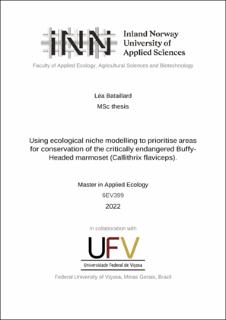| dc.description.abstract | Endemic to the Atlantic Forest in South-eastern Brazil, the Buffy-Headed marmoset (Callithrix flaviceps) has the smallest geographical range of all South American primates. Considered Critically Endangered by the IUCN Red List, this montane primate species is seriously lacking the required attention for effective conservation. However, being the least studied marmoset species, its niche is not well defined. In this thesis, I aimed to model its ecological niche using existing data. Presence-only points of Callithrix flaviceps occurrence as well as environmental variables from external databases were included in the modelling, with the main objectives of (1) defining suitable habitat, and (2) prioritizing areas for conservation and/or restoration. I used Ensemble Modelling to define current suitability considering four climate and two landscape variables. Climate suitability and landscape suitability were modelled first separately, then together to determine overall habitat suitability. To identify areas to prioritize for conservation and/or restoration, I generated predictions for future suitability considering the intermediate (RCP4.5) and extreme (RCP8.5) climate change scenarios for the years 2050 and 2070. From the six environmental variables used in this study, Precipitation Seasonality (BIO15) and tree canopy cover were the most important to predict Callithrix flaviceps distribution. On the other hand, Precipitation of Wettest Month (BIO13) was the least important. Results showed highest probability of occurrence in areas with 70% of Precipitation Seasonality. As expected, tree canopy cover > 80% was positively related with probability of occurrence. Ensemble model output showed that Callithrix flaviceps were most likely to occur at elevations above 1200 m and in areas with Temperature Seasonality (BIO4) between 21-23°C. Results were less clear for Annual Mean Temperature (BIO1) and Precipitation of Wettest Month (BIO13), however, probability of presence was higher for areas with Annual Mean Temperature between 10-17°C and around 210 mm of Precipitation of Wettest Month. Overall, present results show that seasonality is important and that Callithrix flaviceps, being a montane species, prefer colder environment and higher altitude. Maps created to show hotspots for future suitability considering the two climate change scenarios suggest that preservation of the Caparaó National Park is needed, as it is likely to be a key area for the preservation of the species. High climatic suitability but low landscape suitability suggests that restoration of habitat in Serra Das Torres might be a useful strategy. Maintenance and restoration around Augusto Ruschii and Goiapaba-Açu protected areas might help to reach a higher overall habitat suitability. However, the Atlantic Forest being highly fragmented, habitat connectivity must be improved. Results must be interpreted with caution, considering the poor reliability of the occurrence dataset. Moreover, results are limited to the set of variables used, but other variables such as biotic factors and connectivity are likely to affect the Callithrix flaviceps distribution. Future studies including species interaction with C. aurita and the invasive marmosets C. penicillata and C. jacchus are needed to get a better picture of C. flaviceps realised niche. Given the critical status of the species, it is crucial to benefit from all the data available (even if the quality is not ideal). | en_US |
